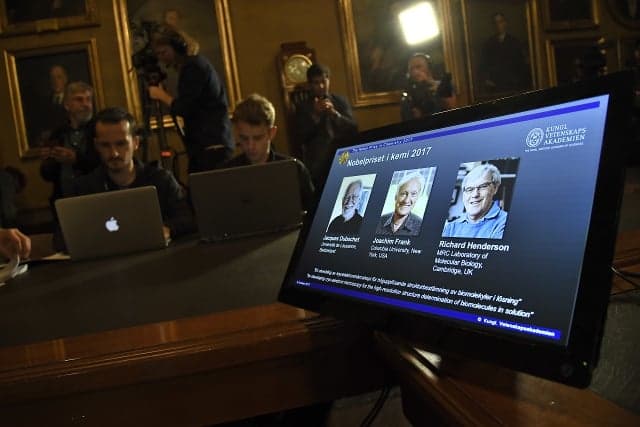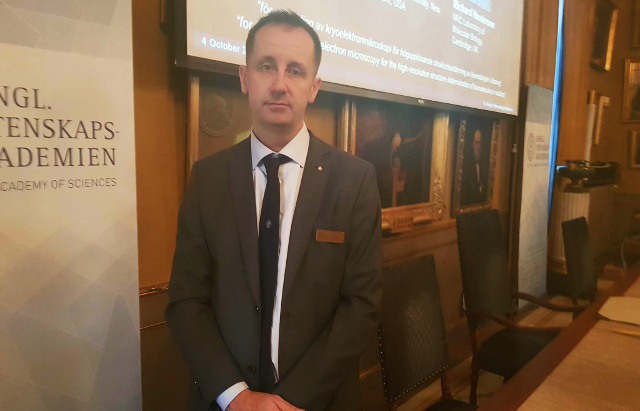Moving beyond blobology: The 2017 Nobel Chemistry Prize explained

Why the Swedish Nobel Committee thinks this year's Chemistry Prize is likely to have very big practical consequences.
The Nobel Prize in Chemistry 2017 was awarded to Jacques Dubochet, Joachim Frank and Richard Henderson "for developing cryo-electron microscopy for the high-resolution structure determination of biomolecules in solution".
BLOG: German-British-Swiss trio win Nobel Prize in Chemistry
This optimized the electron microscope, which means that researchers can now routinely produce three-dimensional structures of biomolecules, and allowed for, for example, the rapid establishment of the Zika virus structure.
We asked Professor Claes Gustafsson, a member of the Nobel Committee for Chemistry and a researcher at the Institution for Biomedicine at Gothenburg University, to help us understand how this works.
Watch the very moment the 2017 #NobelPrize in Chemistry is announced! pic.twitter.com/xwoThkOpn8
— The Nobel Prize (@NobelPrize) October 4, 2017
This year's win is for a technological achievement (cool microscope technology), and new Nobel Laureate Joachim Frank said he thinks the impact is much larger for a technological rather than theoretical breakthrough. Would you agree with that? Or at least understand why he thinks so?
I understand what he's saying and I think the prize this year will have very big practical consequences. It's being used especially in drug development, because we have an opportunity to create three-dimensional images of molecules we've never seen before, that are much more complex and flexible, and produce movies of how these small machines we have in a cell work together.
That leads to basic knowledge of course, basic insight into how these machines work, but it also opens up possibilities of identifying new drug targets, and understand how old drugs we've been using for a long time actually work, their consequences, and can we change their activity in some way? I'd say there are a lot of both basic science consequences, and practical consequences. I think that's shown also in the huge interest there is from pharmaceutical companies who are all building up facilities to use these techniques to look at their drugs and how they interact with targets in the body.
Circadian clock, part of Monday's physiology prize win, one of the structures demonstrated by #NobelChemistryPrize winning instrument pic.twitter.com/b9Zr0WX5p0
— Lee Roden (@LeeRoden89) October 4, 2017
It was mentioned in the presentation that this technique has transformed electro-microscopy from something that could essentially show the outline of bio-molecules, to something capable of showing the details and intricacies. Is it possible to elaborate on how much more advanced this technique is from what we had before?
You're absolutely right, in the old form of electron microscopy you saw the contours, but you didn't see the atoms. The contours are fine but they become pretty meaningless if you want to really understand something, where you need to see the atoms and go into great detail. I would rather compare it with how we got high-resolution images before, when we were forced to use crystallography, and in that method we had to use a lot of material, and we needed to crystalize it and pack them very tightly together. And that's not really how these molecules look in real life, they're in a water solution, they're moving, they're like machines that open up and close, change constantly.
This technique allows you to look at much bigger things than you could do with the previous technique. It also means you don't just look at one confirmation, one posture of the machine, but an entire spectrum of movement. It's like instead of seeing a violinist in an orchestra, you see the entire orchestra. You see how they work together.
"We are facing a revolution in biochemistry" - Nobel Committee Chairman Sara Snogerup Linse on the 2017 #NobelPrize in Chemistry discoveries pic.twitter.com/jLBMLeIFNr
— The Nobel Prize (@NobelPrize) October 4, 2017
We've spoken about practical uses in industry, but what about for students who are learning today? Being able to see these wonderful detailed images of biomolecules must make a huge difference?
I lecture medical students about the basic happenings in the cell, how genes are activated, how they are transcribed and so on, and to begin with this was sort of 'blobology'. There were blobs you made arrows between and so on. Now we can present a complete picture, and understand detailed molecular knowledge, and see each and every atom. And we can understand how a hormone like oestrogen or testosterone binds to something then goes down and touches the complexes that regulate gene expression, and how that leads to responses.
So suddenly, it becomes real. It's something that's not theoretical, it's something very real. It's like learning about how a car works: we understand it in the same type of high-resolution detail now. It's exciting.

Professor Claes Gustafsson. Photo: Lee Roden/The Local
Comments
See Also
The Nobel Prize in Chemistry 2017 was awarded to Jacques Dubochet, Joachim Frank and Richard Henderson "for developing cryo-electron microscopy for the high-resolution structure determination of biomolecules in solution".
BLOG: German-British-Swiss trio win Nobel Prize in Chemistry
This optimized the electron microscope, which means that researchers can now routinely produce three-dimensional structures of biomolecules, and allowed for, for example, the rapid establishment of the Zika virus structure.
We asked Professor Claes Gustafsson, a member of the Nobel Committee for Chemistry and a researcher at the Institution for Biomedicine at Gothenburg University, to help us understand how this works.
Watch the very moment the 2017 #NobelPrize in Chemistry is announced! pic.twitter.com/xwoThkOpn8
— The Nobel Prize (@NobelPrize) October 4, 2017
This year's win is for a technological achievement (cool microscope technology), and new Nobel Laureate Joachim Frank said he thinks the impact is much larger for a technological rather than theoretical breakthrough. Would you agree with that? Or at least understand why he thinks so?
I understand what he's saying and I think the prize this year will have very big practical consequences. It's being used especially in drug development, because we have an opportunity to create three-dimensional images of molecules we've never seen before, that are much more complex and flexible, and produce movies of how these small machines we have in a cell work together.
That leads to basic knowledge of course, basic insight into how these machines work, but it also opens up possibilities of identifying new drug targets, and understand how old drugs we've been using for a long time actually work, their consequences, and can we change their activity in some way? I'd say there are a lot of both basic science consequences, and practical consequences. I think that's shown also in the huge interest there is from pharmaceutical companies who are all building up facilities to use these techniques to look at their drugs and how they interact with targets in the body.
Circadian clock, part of Monday's physiology prize win, one of the structures demonstrated by #NobelChemistryPrize winning instrument pic.twitter.com/b9Zr0WX5p0
— Lee Roden (@LeeRoden89) October 4, 2017
It was mentioned in the presentation that this technique has transformed electro-microscopy from something that could essentially show the outline of bio-molecules, to something capable of showing the details and intricacies. Is it possible to elaborate on how much more advanced this technique is from what we had before?
You're absolutely right, in the old form of electron microscopy you saw the contours, but you didn't see the atoms. The contours are fine but they become pretty meaningless if you want to really understand something, where you need to see the atoms and go into great detail. I would rather compare it with how we got high-resolution images before, when we were forced to use crystallography, and in that method we had to use a lot of material, and we needed to crystalize it and pack them very tightly together. And that's not really how these molecules look in real life, they're in a water solution, they're moving, they're like machines that open up and close, change constantly.
This technique allows you to look at much bigger things than you could do with the previous technique. It also means you don't just look at one confirmation, one posture of the machine, but an entire spectrum of movement. It's like instead of seeing a violinist in an orchestra, you see the entire orchestra. You see how they work together.
"We are facing a revolution in biochemistry" - Nobel Committee Chairman Sara Snogerup Linse on the 2017 #NobelPrize in Chemistry discoveries pic.twitter.com/jLBMLeIFNr
— The Nobel Prize (@NobelPrize) October 4, 2017
We've spoken about practical uses in industry, but what about for students who are learning today? Being able to see these wonderful detailed images of biomolecules must make a huge difference?
I lecture medical students about the basic happenings in the cell, how genes are activated, how they are transcribed and so on, and to begin with this was sort of 'blobology'. There were blobs you made arrows between and so on. Now we can present a complete picture, and understand detailed molecular knowledge, and see each and every atom. And we can understand how a hormone like oestrogen or testosterone binds to something then goes down and touches the complexes that regulate gene expression, and how that leads to responses.
So suddenly, it becomes real. It's something that's not theoretical, it's something very real. It's like learning about how a car works: we understand it in the same type of high-resolution detail now. It's exciting.

Professor Claes Gustafsson. Photo: Lee Roden/The Local
Join the conversation in our comments section below. Share your own views and experience and if you have a question or suggestion for our journalists then email us at [email protected].
Please keep comments civil, constructive and on topic – and make sure to read our terms of use before getting involved.
Please log in here to leave a comment.